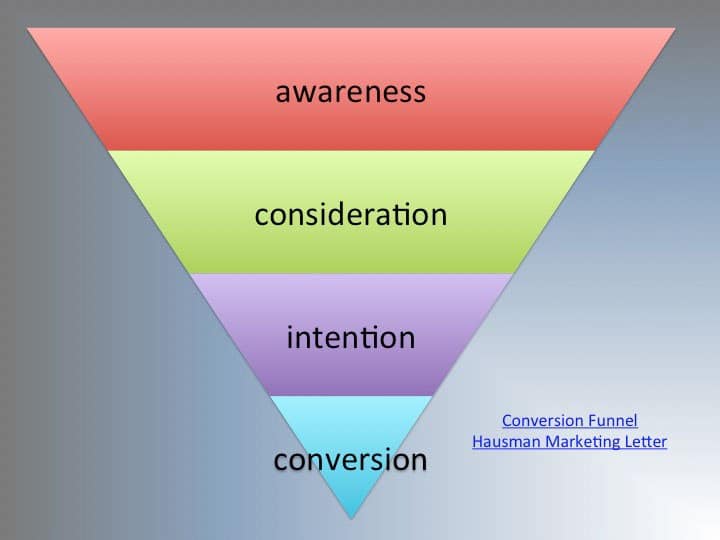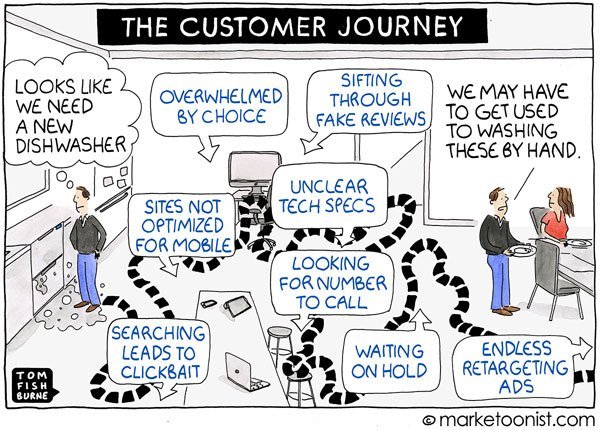
How To Avoid The Dysfunctional Customer Journey
In their sloppy attempts to attract and convert customers, firms are unintentionally creating a dysfunctional customer journey.
The dysfunctional customer journey
Here’s what companies think their customers’ journeys look like:

That is nice, linear, and shows customers moving seamlessly through the buying process which is optimal for both customers and firms.
Unfortunately, the true buying process is messy, non-linear, and often leads to frustration, rather than success for either the business or the customer. For the customer, the journey looks more like this:

Supporting this, a Google search for “dishwasher” turned up almost 250 MILLION results, including paid search results. If you viewed 25 results every minute, it would take just over 19 YEARS to view all the results if you did NOTHING but view results. No eating, no sleeping, no working, no #(@.
Of course, long before you finished viewing all the results, you’d not only be dead, but the number of results would increase and many of the results viewed would be totally obsolete. No wonder customers have a dysfunctional customer journey!!!
Factors contributing to a dysfunctional customer journey
Too much choice
A big contributor to a dysfunctional customer journey is offering too much choice — and when consumers face too much choice, information processing overload causes paralysis. Instead of weeding through 1000s of options, consumers choose to not make a choice.
The key here is to provide appropriate filters to help reduce choice to a manageable number of options — something on the order of 3-5. But, often websites either don’t offer filters or This comes from websites created by a web designer rather than a marketer. For instance, Amazon allows customers to use very few filters in their search for the right product (although we’re not talking dishwashers now). Crafting the proper e-commerce webpage means thinking like a customer and allowing them to filter results based on what matters to them. Marketers are (or should be) trained to consider customers wants and needs in crafting search filters.
An example comes from personal experience. I was looking for a pair of shoes online (I do most of my shopping online because I hate stores). I knew exactly what I wanted: Black, 2″ heal, closed toe, size 7, … However, when I went online, I had to weed through 1000s of shoes that didn’t meet my needs because I was offered filters that didn’t matter to me, such as brand. I’m not brand loyal when it comes to shoes, so that had no influence on my decision.
Now, look at Zappos options that satisfy my shoe search, which only forces me to consider 12 shoes that exactly match my search criterion. No wonder they’ve succeeded in a world where it is counter-intuitive.

My decision is now so much easier, without limiting options that I might like.
Mobile platform information
In today’s world, if you’re not mobile-first in your design, you’re missing the boat. Various reports estimate that 60% of search is now mobile and that number goes up every year. And, while customers might still prefer to shop in stores, they’re spending less time there because they’ve done some preliminary shopping with a mobile device.

- Images are too small and there’s no way to expand them using the familiar pinching motion
- They have to hunt for information such as address, directions, hours of operation, etc
- Information on product specifications is absent or hard to find (this happens on both mobile and desktop)
- Buttons are too close which means they waste time with click errors
- Page load speeds suck
Some companies attempted to “fix” such problems by creating an app, which is one of the dumbest ideas out there. The average mobile user has a mear 35 apps on their device and they only use a handful of them on a regular basis. Finding room for your app among this select group is unlikely.
Retargeting
Retargeting involves sending ads to folks who’ve already raised their hands that they’re interested in your product, for instance by visiting your website, searching for your product, or are an existing customer.
Maybe you’ve noticed retargeting ads as you’ve surfed the net. Your search for car insurance and suddenly every ad you see on a website or social network is about insurance. It’s a little unsettling, especially if you’re concerned about online privacy, but it’s incredibly common. Some searchers routinely use incognito (a service on Chrome where you search anonymously), DuckDuckGo (which doesn’t capture your information) or a search engine like Tor (which surfs totally anonymously by routing your search through various countries to disguise you).
Not only can retargeting be disconcerting, but it’s often a waste of money. The biggest problem occurs when companies retarget a customer who already bought the product as they’re unlikely to be in the market for another soon. I get particularly annoyed when I’m retargeted for a product from Amazon when I already bought the product FROM Amazon. It seems really inefficient that they don’t know I already have the product when I bought it from them.
An advantage to retargeting is that the customer journey isn’t linear (even when there isn’t a dysfunctional customer journey). Customers look around, consider, go back and look at things again. And this loop might go round and round before resulting in a decision. Or customers might purchase a product frequently and it helps to remind them of your offerings. This works best for consumables such as groceries and shampoo.
Solving the dysfunctional customer journey
Understand the problem
An obvious step in fixing the dysfunctional customer journey is to determine how bad the problem is. That means looking at analytics, such as clickstream data, and monitoring consumer statements for dissatisfaction with the website or mobile platform.
Set standards and goals
This is especially important for retargeting programs. Set standards that make retargeting smart, not just in terms of resource allocation, but avoiding a dysfunctional customer journey. Immediately delete customers who bought your product from retargeting campaigns and don’t retarget consumers who have a negative relationship with your firm, such as those who contacted customer service with a complaint.
Create smart filters
By reducing choice, you’ll actually sell more, although this might be counter-intuitive. In our busy lives, we are less interested in being tempted to buy something we don’t need. Show us what we want so we can buy your products fast and easily. It’s ok, after the purchase, to suggest additional products we might like. If we have the time or inclination, we’ll think about such additional purchases.
Mobile-first
This suggestion doesn’t just apply to avoiding a dysfunctional customer journey. All your online marketing efforts should be mobile-first.






